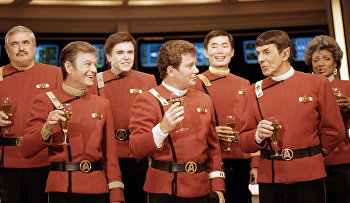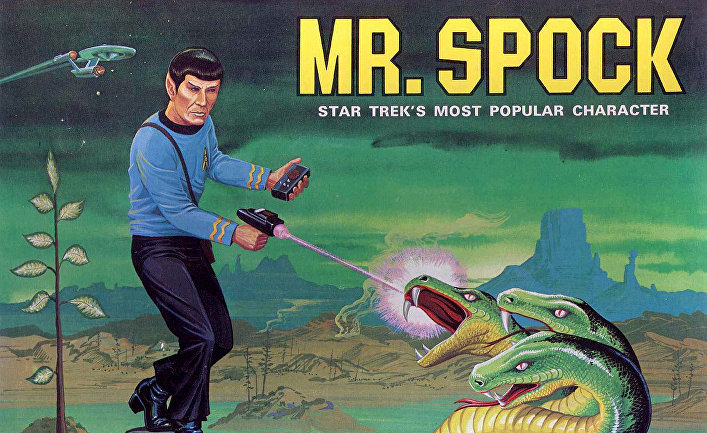If there are two sci-fi classics which have penetrated real-life culture, they are Star Wars and Star Trek — and they're front-of-mind again now. The movie-theatre release of the latest Star Wars epic, alongside the announcement of a new Star Trek series, gives us a chance to contemplate two strikingly different visions of the future — along with fan rivalries between devotees of the two series. Fans have entirely differing perceptions of how technologies will work and develop — although this, too, is a recurring theme.The social and political make-up of these two contrasted future societies are reflected by the differing uses to which these technologies are put. Each aspect both enables, and is influenced by the other.
In many ways the political norms of each society affect the developments which they demand of technologies. Yet the very limitations of these technologies simultaneously shape the societies and political realities which depend upon them, creating an interdependence between lifestyles and technologies. This makes it worthwhile analyzing the technological developments seen portrayed in the two different series, from various viewpoints — if only because future social and political developments may go hand-in-hand with such innovations.

We can hardly fail to notice the sharp differences between the technologies in the two different series. The ethos of Star Wars can almost be called medieval by comparison with the cutting-edge technologies of Star Trek. The galaxy ruled by the Empire seems strikingly similar to the American West — in which advanced innovation thrives cheek-by-jowl with primitive creatures.
Compared with this, the high-tech developments in Star Trek border on science fiction. It seems fair to mention that most of the episodes in these series are shot on film sets rigged-out as spaceships — aboard which advanced scientific innovation offers the key to survival. In the only series of the epic which is set aboard a remote space-station, Deep Space Nine (DS9) we meet beings who are not Federation members, and therefore lack access to the Federation's high-tech hardware and fringe benefits. There are other factors besides these contrasts which differentiate these two very dissimilar technological worlds — and it seems worth summarizing them briefly below.
Intercommunications as a system
Warp factor travel, faster than the speed of light, is not only a theoretical reality in Star Trek (despite being impossible in reality) but is simultaneously part of a complete system of other shipboard components — shields to protect the spacecraft; tractor beams; invisibility cloaks; and hologram projections. The replicator-based transporter and the hand-held phasers are all exactly the same as those aboard the mother-ship. Meanwhile in Star Wars we see a certain amount of technical skulduggery. Although there are tractor beams, levitation systems and deflectors, there is no invisibility cloak, nor any sign of a propulsion system capable of faster-than-light speeds.
Jedi laser sabres need to pack a powerful punch while taking up little room — yet this energy source goes untapped in any other kind of application. Creating such laser weaponry seems to depend on secretive arts dependent on mastery of The Force, rather than on any particular technical know-how. The ability to construct anything as complex as the Death Star or a Star-Destructor defies our imaginations — yet the Empire's spaceships, judging from their internal functionality, look like left-over hulks from WWII, crewed by scores of Imperial stormtroopers, flight-crews, gun brigades, and the vast technical team who keep the ships operational. This is a world in which huge projects require tough decisions, the ability to speak in the language of men, and to operate various craft — although computers are always there in the background, just as in contemporary life, as well as on spaceships — just like the thousands of crew-members. The command deck of the Millennium Falcon, discounting its weaponry, looks more like the flight deck of a passenger airliner from the 1950s than any engineering marvel designed to fly us to the stars. These bizarre technological contradictions lead to peculiar anomalies and anachronisms that chop up the storyline and undermine its credibility.
Who takes the political and economic decisions?
As mentioned above, the political and economic order arises from the adoption of different kinds of technologies. These issues depend both upon the level of scientific achievement and the degree to which such technologies are resourced. The way such choices are made affects the technology chosen, which makes it worth analysing how the political and economic decisions are made in both of these series.
In fact the differences are not major. In Star Wars there are class-based and economic distinctions — in other words, there are poor people, slaves, crooks, the super-wealthy, and numerous grades of aristocracy. Meanwhile in Star Trek we find a much more even distribution of wealth, in which most people — within the Federation, at least — have everything they need. There is no money that we ever see. The only form of currency is Latinium, greatly treasured by the humanoid Ferengi — some of the more lovable creatures to appear in Star Trek. Unsurprisingly Latinium turns out to be a poisonous substance. The political set-up in Star Trek seems to place more-or-less able and competent individuals in positions of authority — regardless of their social origins or financial status.
#StarTrek The Official Guide to Our Universe: The True Science Behind the Starship Voyages https://t.co/R7zHhhtXbO pic.twitter.com/txrqAcngHp
— VisionaryTrek (@VisionaryTrek) November 19, 2015
In Star Wars the entire fate of the galaxy seems, at first appearances, to lie in the hands of a single family — while much depends on a vicious running feud between two rival clans of knights, neither of whose exploits or achievements seem much better than the other's. Money continues to flourish, particularly in the form of hard cash — notably in a buoyant black economy with all the usual trappings… crime, smuggling, robbery, and no-go regions. We see a hierarchical society in which accident of birth and clan membership determine an individual's fate and position in society. By comparison with Star Wars even the worst indulgences of Rome at its height seems tolerably mild.
Where is life better?
Society in both series has many benefits — it's hard to say where life is better, since so much depends on individual perspective.
The Star Fleet in Star Trek is not intended to be a military operation, yet it conducts reconnaissance missions. Despite Star Fleet's use of military-style ranks — admiral, captain, and so forth — it remains more like the police, or even the fire brigade, than the army. Its had far more in common with a security service than a military outfit. By the same token, the Federation has no army to speak of, yet can raise Star Fleet in the event of emergency.
Each time I think about #basicincome and the progression of labor in the future, I think about #StarTrek pic.twitter.com/h9jXl8oYpY
— Chaz Carlson (@thechaz) November 24, 2015
By contrast, the Empire in Star Wars maintains a vast standing army, deployed throughout the entire galaxy, and involved in operations as diverse as sieges, battles between spaceships, saving (or destroying) planets, and providing a peacekeeping force. In the strictest sense Star Wars is the story of a civil war between tyranny backed by an all-powerful army, and rebels with a considerable manufacturing operation but far scanter military resources. Comparing the two series, it becomes clear that it would be more practical to live in one of them, but more interesting to live in the other.
Make it so
Quite possibly, reviewing all of the above, the results of creative thinking have materialized as new innovation, first seen in Star Trek, and then going on to become a part of our everyday lives. The ideas in Star Trek have genuinely filtered down into the development of real-world technologies, because — whether consciously or unconsciously — Star Trek has played a role in rolling-out such gadgets.
Communicators are today's mobile phones, and mobile computers are today's tablet devices. We now have medical instruments which perform a full range of tricoder functions, and can even supplant hyperspray. We already have electronic interpreting software, despite its inclination to make glitches, and our question-and-answer software is compatible with anything we might find aboard the Star Fleet flagship. There are even tractor beams in existence — admittedly only in miniature versions. Metamaterials offer the possibility of invisibility in future applications. Even the Star Trek computer interfaces have influenced the look of touch-sensitive screens on tablet devices, along with a host of websites.
New "tricorder" #technology might be able to "hear" tumors growing | @Stanford https://t.co/q5whoruRLI #startrek pic.twitter.com/RnyG8uElU6
— Faculti (@FacultiNet) November 11, 2015
Star Wars has primarily inspired toys and games. A huge range of technologies seen in the films have taken their lead from innovations already in production — bionic construction, solar batteries, robots, holograms, lasers, clones, and so forth. There are few genuinely revolutionary new developments in the Star Wars galaxy — things there primarily replicate real-life developments.
This means that Star Wars presents an expanded version of modern-day life with a few medieval touches — such as a feudal system, social inequality, and mysticism — with little in the way of technological innovation. Over in Star Trek, we see a panorama of life in the future which is far improved on that of our own — with highly developed scientific advancements. What we see in the latest films sets the benchmark for new developments in real life. It follows that Star Trek is likely to become prophecy — while Star Wars can at best be seen as a pessimistic view of a future which we strive to avoid.








